
Ready, wool yarns, wool felt, leather, cotton fabric, day lily leaves, rubber, plastic bags, mulberry paper, wood, rigid foam, stone clay, acrylic paint, 14 x 20 x 18 inches. © 2020 Eve Jacobs-Carnahan
Knitting feathers for my bird sculptures
I’m a fiber artist, so I work with fiber: yarn, felt, fabric, paper. When I want to create the impression of feathers on my bird sculptures, I look to the textures in knitting. I start with something familiar and stretch it in new directions.
In the days when I knit sweaters and hats, I was fascinated by the intricate stitches. Working the yarn with my fingers, I could literally feel the textures as I made them. In my artwork, I try to give highlight the textures of the knitted yarn.
Artists have pursued texture for hundreds of years. Oil painters like Vincent Van Gogh used the impasto technique to capture motion, light, and texture. They have also distressed the painted surface with tools and mixed the paint with sand, as William deKooning did.
I create textured surfaces by layering and twisting the yarn as I knit. Combining the smooth knit stitch with the bumpy purl stitch by crossing, twisting, and elongating them, creates an endless number of textures.
Adapting knitting patterns for artwork
To find the right texture, I start by looking through knitting pattern books like these classics: The Harmony Guide to 440 More Knitting Stitches and Barbara Walker’s A Treasury of Knitting Patterns. You can see my copies are well-worn. When the binding of my Harmony Guide began to fall apart, I slipped the pages into plastic sleeves and put them in a 3-ring binder.
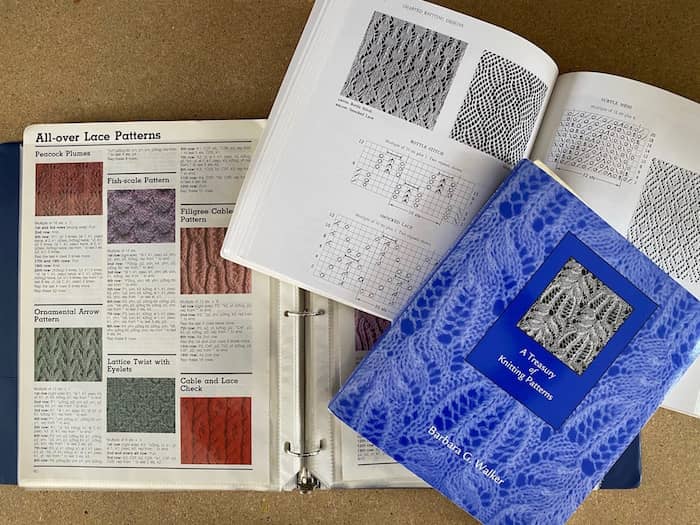
photo by Eve Jacobs-Carnahan
As I peruse the patterns, I try not to the look at their names. Instead, I try to see the shapes: triangles, diamonds, scallops. I don’t want to be influenced by the names, because patterns called latticework or pine trees might be just as suitable for bird feathers as ones called waves or fish scales. Oddly enough, I have found very few suitable knitting patterns with the feather in them.
I try to test the pattern on a couple of types of yarn to see how it looks. The thickness of the yarn and the size of the needles can make the same pattern appear very different. Knitting the piece in thick yarn and large needles makes everything larger as the pattern is exaggerated.
Three knitting patterns for bird feathers
I am working on a set of green herons for an installation about gerrymandering. (I wrote about the conceptual inspiration for this piece in July 2019. I interrupted the herons to make a site sculpture on a lamppost and work on my collaborative art project Knit Democracy Together, so I’m returning to them now in 2021.) Since these birds are fairly large, there is ample space on their backs to incorporate complex patterns with many rows and repeats.
For the first heron in the set, I chose the Ribbed Ripple Weave pattern. The lines in this pattern are exaggerated by deep ridges created by the k1, p1 ribbing. The result looks as if someone dragged a comb through the surface at different angles. Those colliding lines help create the sense of overlapping layers, even though there is only one layer of fabric.

Notes and knitting chart for Ready © 2021 Eve Jacobs-Carnahan
Another factor that affects the appearance of the texture is whether the yarn is a solid color or a heathered mixture of colors. I was surprised at how well the three-ply yarn blue and white handspun yarn worked in this pattern. I was afraid the yarn might be too stripy. That’s why it pays to make test swatches.
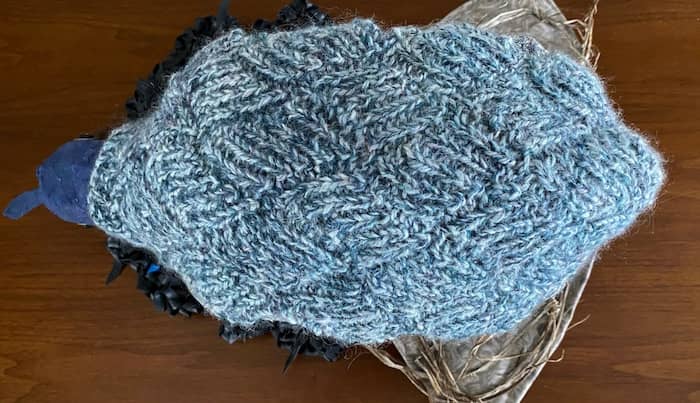
Ready (detail), knitted back of bird seen from above 14 x 20 x 18 inches. © 2020 Eve Jacobs-Carnahan
For the second heron I selected a pattern with interlocking diamonds. I broke up the rigid rows of diamonds by making three strips of knitting for this bird. You can see them pinned in place in this next photo. The strips on the side come in at an angle, so the diamonds change direction where the wing meets the back.
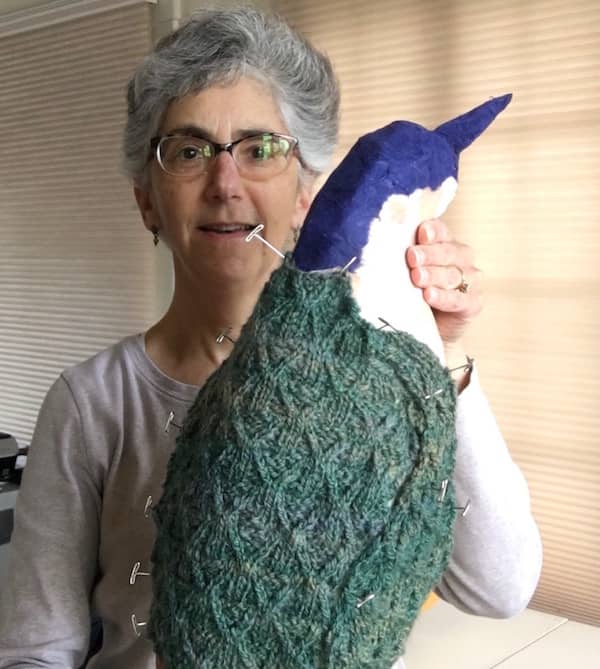
Calm, work in progress, knitted sections evoking feathers pinned to armature. © 2020 Eve Jacobs-Carnahan
Finding the right pattern requires flexibility. I had selected a latticework pattern for the third heron, because I was attracted to the twisting lines. Here’s a picture when I was about halfway finished with the knitting.
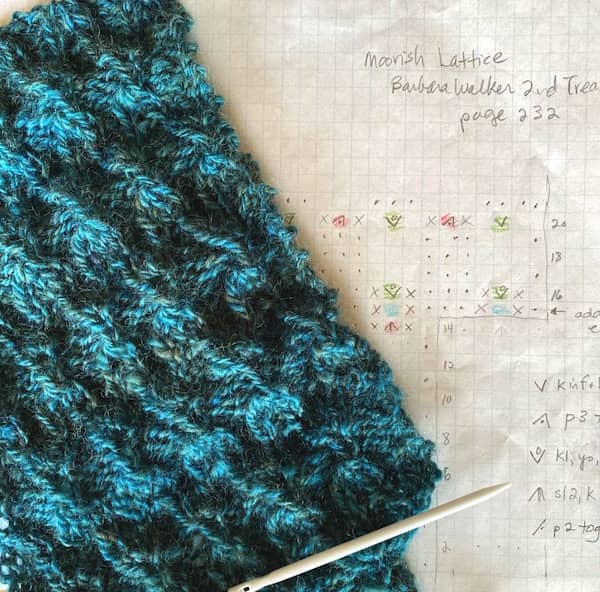
Notes and knitting chart for green heron feathered back © 2021 Eve Jacobs-Carnahan
It was okay, but as I worked the rows back and forth, turning the knitting over each time, I decided the “wrong” side was more feather-like. That’s one of the cool things about knitting! The reverse side of the pattern might be just what you need. You can see the same knitting pinned in place with the reverse side now as the “right” side in the next section below.
Highlighting knitted textures through contrast
In order to highlight the stitch textures in my finished sculptures, I need to draw attention to them. I have learned that if the knitting is set off against a smooth surface, like cotton fabric, then the texture becomes more prominent.
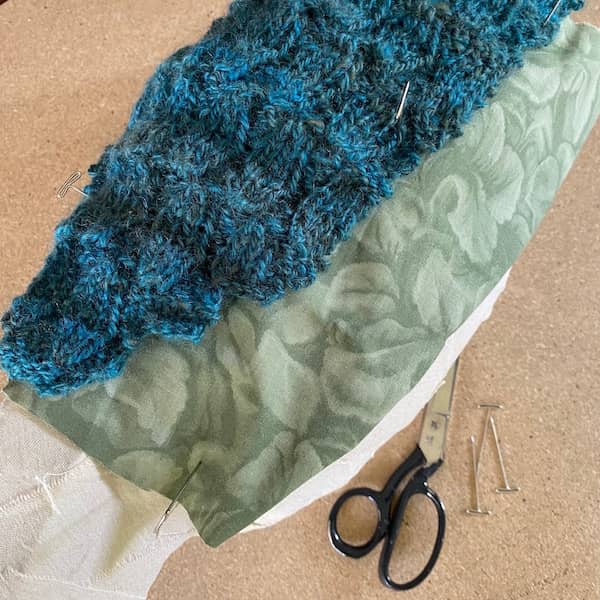
work in progress, green heron © 2021 Eve Jacobs-Carnahan
Real birds have feathers of different length and structure, depending on their purpose and location on the bird’s body. For these herons, I’ve used other materials for in addition to the cotton fabric to contrast with the knitted feathers of their backs and wings. I felted wool to cover the birds’ breasts and I covered their heads and beaks with mulberry paper. Here are the first two herons on their perches. You can see more photos of these two and find out what prompted me to incorporate day lily leaves here.
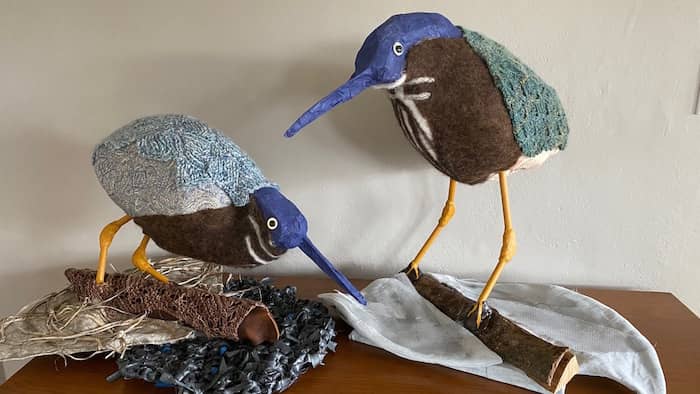
Calm, wool yarns, wool felt, linen, cotton, wire mesh, mulberry paper, wood, rigid foam, stone clay, acrylic paint, 19 x 19 x 14 and inches, and Ready, wool yarns, wool felt, leather, cotton fabric, day lily leaves, rubber, plastic bags, mulberry paper, wood, rigid foam, stone clay, acrylic paint, 14 x 20 x 18 inches. © 2020 Eve Jacobs-Carnahan
0 Comments